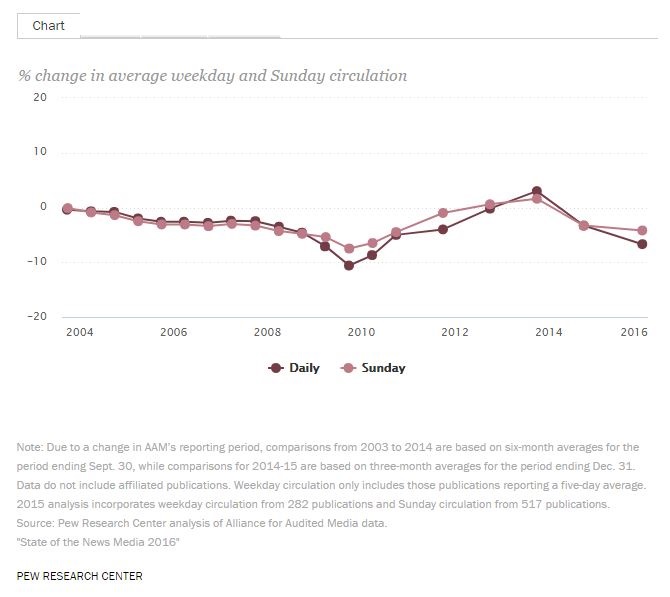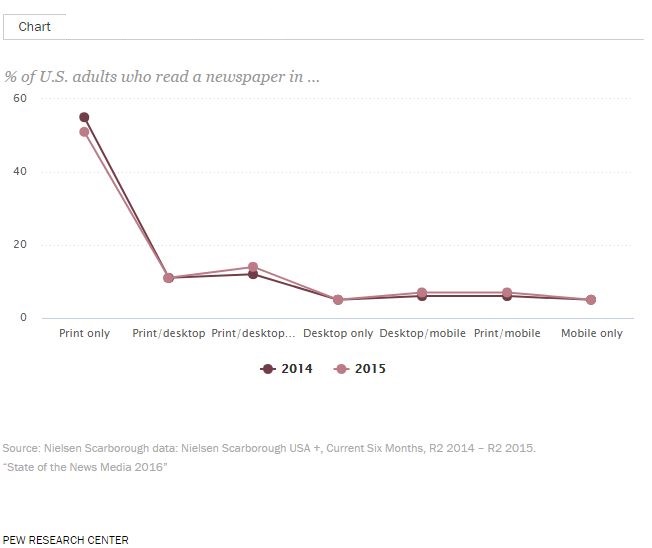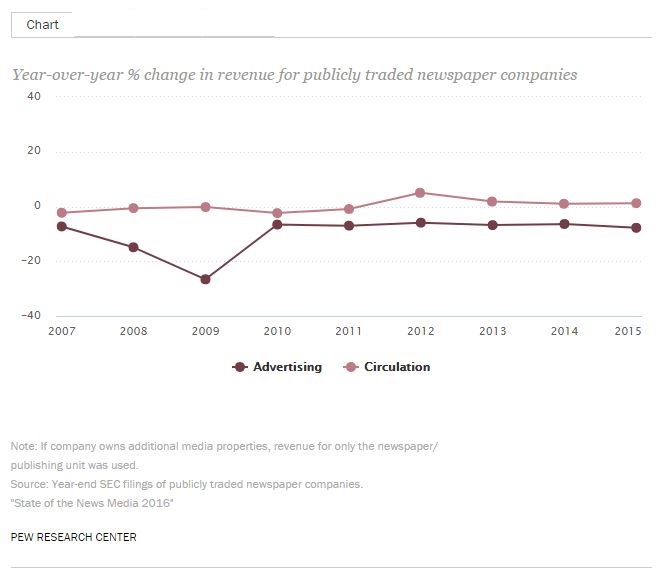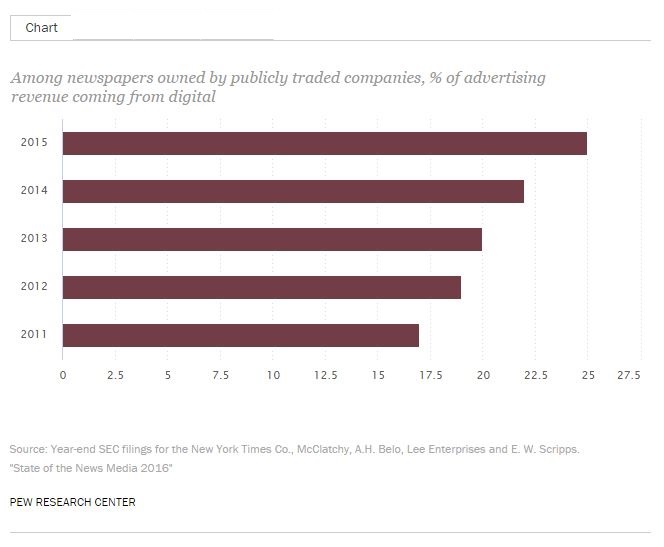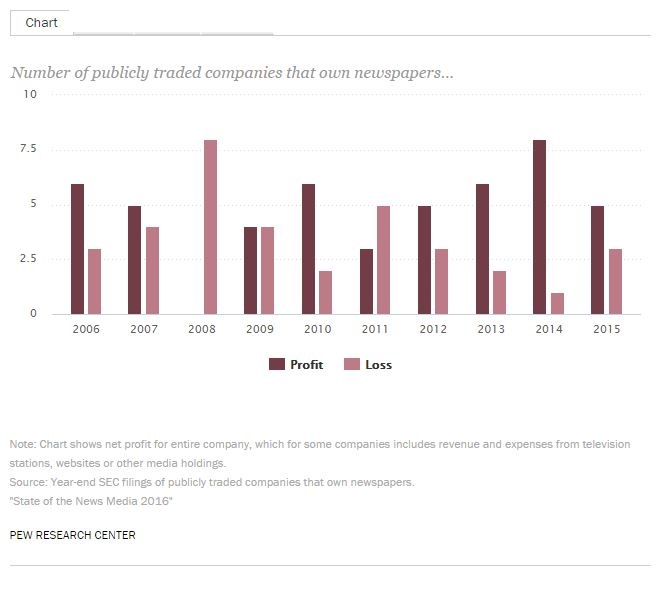Newsroom employment continues to fall
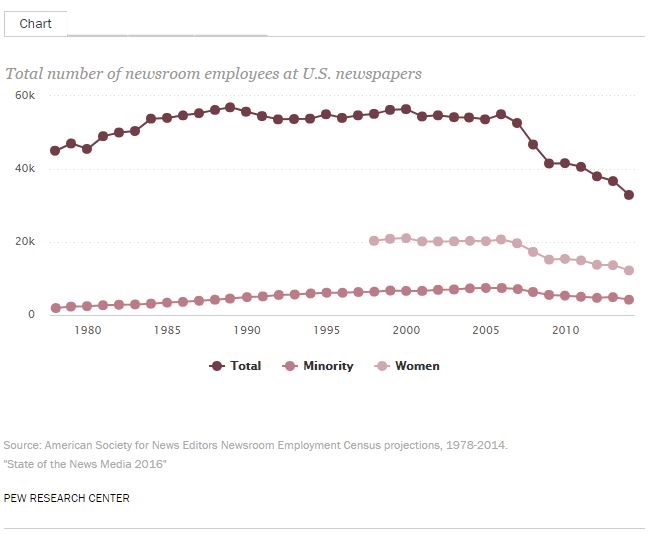
While ASNE will not release 2015 figures until later in 2016, it is likely that 2015 will also experience a noticeable decline. Major staff cuts occurred between April of 2015 and spring 2016 at the Philadelphia Inquirer and Daily News, Tribune Publishing (including the Los Angeles Times and the Chicago Tribune), the Wall Street Journal, the New York Daily News, the San Diego Union-Tribune, the Orange County Register, McClatchy’s foreign bureaus, the Seattle Times and Newsday, the Denver Post and the Boston Globe. (Globe editorial employees also spent one Sunday helping to deliver the paper.)
The number of female newsroom employees fell at roughly the same rate as newsroom employment overall (11%). Women have made up 36-38% of newsroom employees since ASNE began measuring their employment in 1998. The percentage of minority employees remained steady at 13%. A report this year found a persistent wage gap by gender and race at The Wall Street Journal and Dow Jones, one that is common across newspapers.
Ownership
After a year of media companies spinning off their newspaper units into stand-alone companies, the newspaper industry saw a wave of consolidation between spring 2015 and spring 2016. E.W. Scripps and Journal Communications, both of which had been spun off as newspaper-only units from larger media conglomerates, merged into a new company called Journal Media Group. The merged company was then purchased by Gannett, itself newly a stand-alone newspaper company after Gannett’s television and digital holdings were incorporated as TEGNA. Meanwhile, a deal to sell Digital First Media as a whole fell through, and the company instead sold 11 papers to Gannett. And New Media Investment Group continued its string of acquisitions, with more planned.
Tribune Publishing, owners of the Chicago Tribune and the Los Angeles Times, purchased The San Diego Union-Tribune in the spring of 2015, but by August, the company’s stock price had fallen 51% since the company was spun off from Tribune Media in August 2014. Subsequently, it rejected a purchase offer for the L.A. Times, prompting protests from the city’s civic leaders, and in November News Corp. founder Rupert Murdoch suggested the company as a whole might be up for sale. Following this turmoil, Tribune removed its CEO, Jack Griffin. Uncertainty over Tribune’s future continues, however, most recently with Gannett’s public takeover bid in April 2016.
Freedom Communications, owners of The Orange County Register and other papers, faced a series of setbacks in 2014 and filed for bankruptcy in 2015. In the resulting auction, Tribune Publishing initially came out on top, which would have given it control of three major dailies in Southern California. Instead, the Department of Justice raised antitrust concerns with the sale, and Tribune bowed out – paving the way for Digital First Media to make the purchase instead.
Not all purchases saw their details made public. The Las Vegas Review-Journal was acquired from Gatehouse Media by a newly created private investment group, and at first even the paper’s own employees didn’t know their new owner’s identity. After it became known that the investment group was controlled by the family of casino owner Sheldon Adelson, the paper’s editor stepped down in protest. Elsewhere, the major Philadelphia newspapers reorganized under a new nonprofit. And in New York, the Daily News was up for sale, but they were carrying so much debt that Cablevision wouldn’t even agree to purchase at a price of $1. In sunnier news, The Washington Times had its first profitable month in 33 years. Overall, however, the value of newspaper companies has declined.
Several papers closed for good, including the Oakland Tribune and The Cheraw Chronicle. Editor & Publisher’s Newspaper DataBook identified 1,331 daily newspapers in the U.S. in 2014 (the most recent year for which data are available), down from 1,457 in 2004.
The number of daily newspapers has decreased by more than 100 since 2004
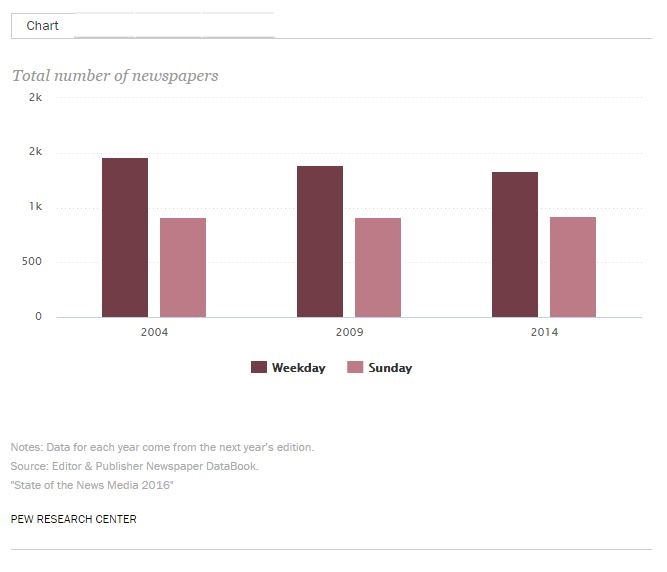
Digital
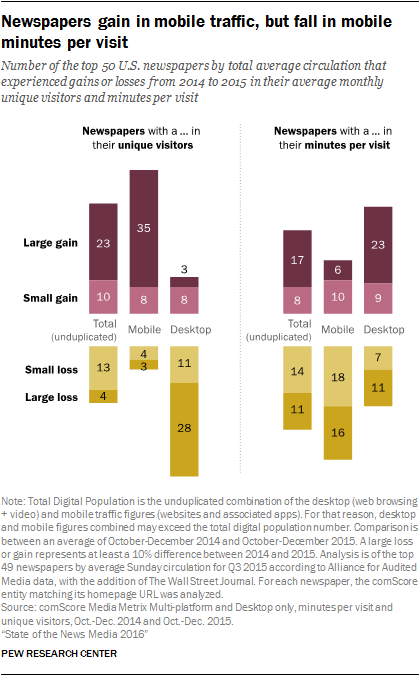
In 2015, the online audience for newspapers continued its shift to mobile devices. Unique visitors rose from 2014 to 2015 for a majority of the top 50 U.S. newspapers, while average minutes per visit rose for half of the 50. However, both of these measures differed between desktop and mobile traffic. For 39 of the 50 newspaper websites examined here, the number of unique visitors on desktop fell, with 28 showing a drop of at least 10%. Conversely, unique visitors on mobile rose for 43 of the 50, with 35 showing a 10% or greater increase.
The opposite was true for time spent, as minutes per visit on a mobile device fell even as unique mobile visitors grew. Though average monthly minutes per visit rose overall for 25 of the 50 newspapers, minutes per visit on desktop rose for 32, and by 10% or more for 23 of these. Time spent on mobile, however, fell for 34.
As in 2014, mobile traffic outpaced desktop traffic by a considerable margin. For 44 of the 50 papers, mobile unique visitors exceeded desktop unique visitors by at least 10%. And just as in 2014, time spent on desktop was generally greater than time spent on mobile. For 41 of the 50 papers, average time spent per visit on desktop was 10% or greater than average time spent on mobile. This is true of internet usage more broadly – but for the total U.S. internet audience, there are generally more desktop visitors per month than mobile visitors.
As mentioned above, newspapers’ web traffic outpaces their circulation by a substantial margin. For the 49 of these U.S. papers reporting Sunday circulation (The Wall Street Journal does not publish a Sunday edition), average monthly unique visitors for the third quarter of 2015 was anywhere from two to 78 times greater than average Sunday circulation for the same period. This is the case despite the fact that more people self-report reading newspapers in print than in a digital form. This points to the difficulty of diagnosing the digital health of newspapers. Web traffic is high, but a reader who stopped by for only one article may be counted the same as a subscriber who visited daily. Clearly, however, many of these one-time visitors do not think of themselves as newspaper readers – and, indeed, single-article visitors may only stay for a short amount of time, while subscribers could spend considerably more time on the site in a month. The challenge for newspapers, then, is to convert these grazers into loyal readers.
One new reality of the digital age is that some foreign papers have established themselves with American audiences, especially ones from the UK. Indeed, many are accessed as often as some American papers by U.S. internet users, even though Americans largely do not have access to print editions of these papers. U.S. web traffic coming to dailymail.co.uk or theguardian.com (measured in terms of unique visitors) would place them within the top five U.S.-based newspapers by web traffic, while telegraph.co.uk and independent.co.uk would rank in the top 10. The top 50 would include papers from Australia, Canada, India, Ireland and New Zealand.
One area of added momentum has been around experimentation with new digital approaches. In 2015 and 2016, these ranged from virtual reality and chatbots to new distribution methods and embracing metered paywalls. Internationally, both the UK’s The Independent and Canada’s La Presse mostly dropped their print editions and went online-only, with La Presse putting a particular focus on their tablet edition, while Turkish papers responded to a government shutdown by publishing on Twitter. Local papers’ efforts to attract online audience included video and big multimedia features. And, like other news organizations, newspaper companies considered how to address the new wave of ad-blocking technology. There were some notable successes in the digital realm: The New York Times reached a million digital-only subscribers, while The Washington Post massively increased its web traffic.


